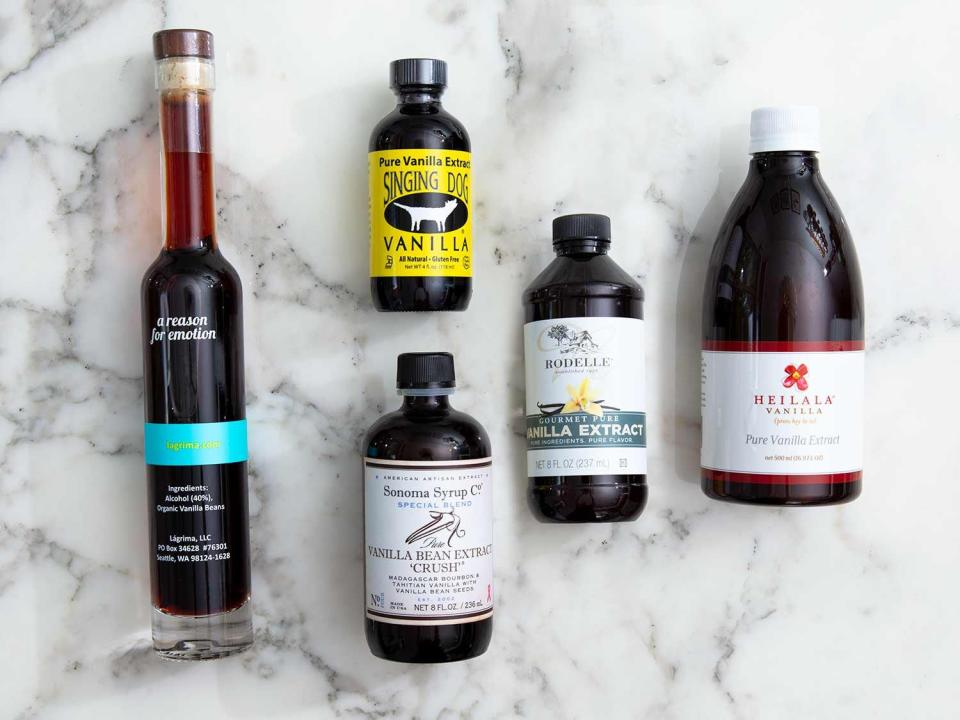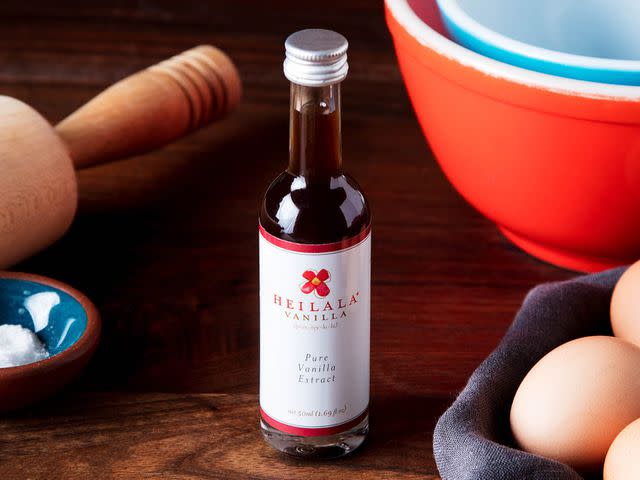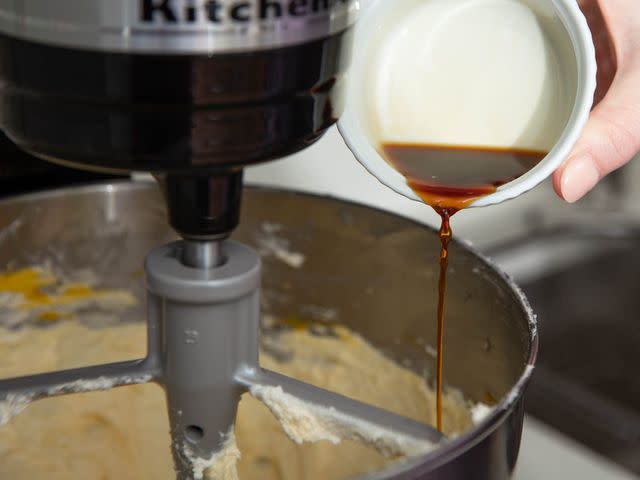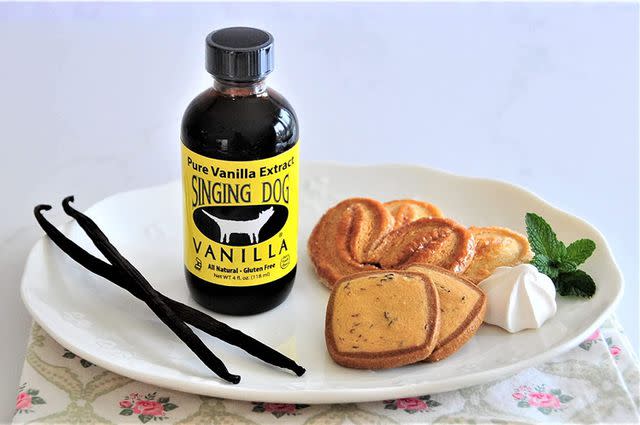Real Talk: DIY Vanilla Extract Is a Waste of Time and Money
However charming the idea, homemade vanilla extract isn't an extract at all; here's why you should stick with the commercial stuff.

Serious Eats / Vicky Wasik
As a baker who's staked her reputation on making everything from scratch, whether ice cream cones and Klondike Bars or the rainbow sprinkles from my book, it surprises folks when I say that vanilla extract is something I'd never, ever make from scratch.
That's because shoving a few vanilla beans in a bottle of vodka is a simple infusion at best, not a genuine extract, and pretending otherwise is to completely misunderstand the complexity involved in manufacturing a high-quality vanilla extract (and to ignore the limitations of working on such a product at home).
How Is Vanilla Extract Made?
Explaining exactly how vanilla extract is made will vary from brand to brand, and whether a producer favors a hot or cold extraction (more on that in a bit), but the best will always start with a blend of vanillas. That can mean anything from vanilla beans sourced from different countries (say, Ugandan and Tongan beans); from different varieties (a blend of Vanilla planifolia and Vanilla tahitensis); or simply from different farms across a single growing region (most famously, Bourbon vanilla—named for the island, not the booze—in a region that encompasses all vanilla grown in Madagascar and the islands of the Indian Ocean).
And, of course, producers aren't taking their chances with random packs of vanilla purchased online. They work directly with the farmers on the ground (in some cases, as with Nielsen-Massey and Rodelle, that relationship may extend back through several generations).
Working closely with farmers allows vanilla producers to secure vanilla beans that meet their exact specifications, from length and weight to curing style and age; it also ensures the farmers get the best price for their product, as there's no middle man to contend with (some producers, like Heilala, have centered their mission statement around this relationship).

Serious Eats / Emily Dryden
This kind of diversity ensures a robust vanilla extract that has tremendous complexity from the start, even before producers continue to foster that complexity with all the other variables of production; these include particle size for the chopped beans, holding temperature, pressure, the number and strength of each ethanol wash, among other factors (such as bottle aging, where new flavors and a smoother profile emerge through esterification).
How Extraction Works
Cold extractions generally involve processing the vanilla through various quantities and percentages of ethanol under constant circulation, for weeks or months, with each round aimed at pulling out a different range of vanilla's 400+ compounds. By changing the ethanol percentage with each wash, a new range of flavor can be extracted. In the end, these individual washes are blended together to create the finished vanilla. Broadly speaking, cold extractions tend to have a character that's more fruity and floral, sometimes with rum-like qualities.
Hot or pressurized extractions may involve all of that and more, as the vanilla beans and ethanol may be held at various temperatures and pressures, each likewise suited to extract a different range of flavor compounds that will later be blended into a single product. Some producers may use percolation to extract yet another range of vanilla compounds. This type of vanilla tends toward a darker character, with notes of caramel, dried fruit, or even oak.
Whether the production is hot or cold, putting blended vanilla beans through multiple rounds of extraction pulls out the most dynamic range of flavor compounds (some water-soluble, some alcohol-soluble, some available at only this temperature or that pressure). The result is a concentrated extract that's robust enough to shine through in our favorite recipes, whether the vanilla is meant to provide an aromatic lift or stand on its own.
All this to say, a few vanilla beans poked into a bottle of bourbon may have a nice flavor and aroma, but it's not concentrated or layered in any way. If I had vanilla beans on hand, I'd sooner flavor a dessert by incorporating seeds from the pod or splitting the bean to infuse directly in the recipe's liquid (at least then I can use heat to my advantage).
But when I'm looking to add a concentrated dose of flavor and/or aroma to my desserts, whether cookie dough or cake batter, a spoonful of top-notch vanilla extract is the fastest, easiest, and most cost-effective option—particularly when buying vanilla extract in bulk compared to those tiny, one-ounce bottles at the store.

Serious Eats / Vicky Wasik
I've mentioned in the past that I don't have a single favorite brand of vanilla. I like to play the field and sample the expressions made possible through so many styles of blending and extraction, and I enjoy the way different vanillas can make old recipes feel new. But here's a peek at what's in my cabinet right now (and, if you missed it, here's what's been in my cabinet before).
Vanilla Extracts to Know and Love
Rodelle
With a wind-powered facility in Colorado and a vertically integrated supply chain based on farmer-owned cooperatives, Rodelle puts a huge emphasis on sustainability, yet its products are easier to find than most (stocked by supermarkets and warehouse clubs alike). Its percolated vanilla extracts come in a wide range of styles, from the raisin-y qualities of Rodelle Gourmet to the oaky, leathery notes in Rodelle Pure and even to a barrel-aged vanilla with its Rodelle Reserve.
Rodelle Gourmet Pure Vanilla Extract, 8 Oz

Rodelle Reserve Pure Madagascar Vanilla Extract, 6.75 Oz

Heilala
Heilala was established in New Zealand, and works directly with farmers in Tonga to produce a very creamy yet earthy vanilla, with almost butterscotch notes. The best value on this cold-processed vanilla is to invest in a big bottle upfront, which drives the cost down to about $4/ounce.
Heilala Pure Vanilla Extract

Sonoma Syrup Co.
This California producer makes a really interesting extract from Madagascar and Tahitian beans, giving it a very classic vanilla profile overall but one that's more floral and aromatic. Its vanilla bean "Crush" is flecked with seeds, so be sure to shake it well before using.
Sonoma Syrup Co Vanilla Bean Crush Extract

Buy at Shop.kingarthurbaking.com
Nielsen-Massey Indonesian
Nielsen-Massey is one of the most well-known vanilla producers in the US, so it requires no introduction; its cold-processed extracts are familiar to both experienced and newbie bakers alike. It's the Indonesian vanilla extract that I like the best; it's more floral than a classic Madagascar-style but not as delicate as Tahitian extracts can be, so it's a little more versatile.
Nielsen-Massey Indonesian Pure Vanilla Extract, 4 Ounces

Singing Dog
While seemingly a bit scrappier than the other brands on this list, Singing Dog works directly with farmers in Papua New Guinea and Indonesia, and its vanilla extract surprised me with its buttery character. It's a lighter, more delicate style than I'm used to, but it works well in low-heat applications like no-bake cheesecake or American buttercream.
Singing Dog Vanilla Pure Vanilla Extract, 2 Fluid Ounces

Lágrima
Packaged in a preposterously tall bottle, like a balsamic, this cold-processed vanilla from Lágrima is definitely a vanilla for gifting rather than everyday use. It's a Ugandan vanilla, with a characteristic earthy yet creamy profile (think: milk chocolate) that's an interesting change of pace for bakers exploring vanilla styles but not so wildly different as to feel unfamiliar.
Lagrima Pure Vanilla Extract, 200 ml

For bakers who haven't explored vanilla extract beyond mass-market brands, it's natural to find an allure to the concept of homemade. But the resources, expertise, and technique that go into high-quality, artisanal vanilla extract is far beyond what even the most competent chef could accomplish at home, resulting in a product that's well worth the price.
December 2019

